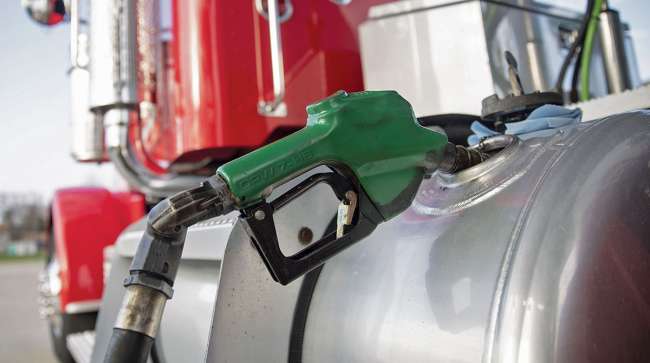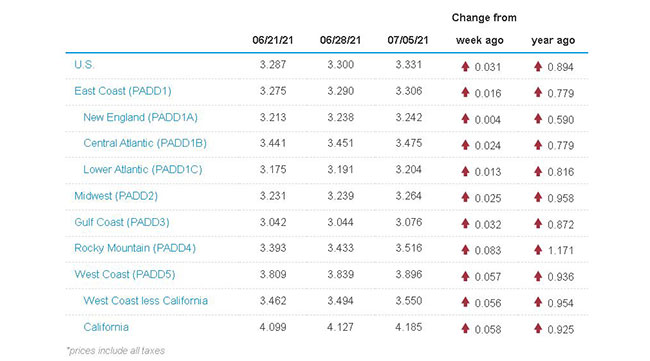Senior Reporter
Diesel Rises 3.1¢ to $3.331 a Gallon

[Stay on top of transportation news: Get TTNews in your inbox.]
The national average price for a gallon of diesel rose 3.1 cents to $3.331 a gallon, according to Energy Information Administration data released July 5.
According to EIA, the price of trucking’s main fuel has increased for 10 consecutive weeks and now costs 89.4 cents more than it did at this time in 2020.
This week’s rise was the largest since a 6.3-cent surge to $3.249 a gallon May 17.
U.S. average on-highway #diesel fuel price on July 5, 2021 was $3.331/gal, UP 3.1¢/gallon from 6/28/21, UP 89.4¢/gallon from year ago https://t.co/NYYhpKKdgN #truckers #shippers #fuelprices pic.twitter.com/cw6heuLjux — EIA (@EIAgov) July 7, 2021
The last time diesel registered a decline was April 19, when it fell a half-cent to $3.124 a gallon.
The average price for a gallon rose in all 10 regions in EIA’s weekly survey, with the biggest gain — 8.3 cents — in the Rocky Mountain region.
The average price for gasoline rose last week by exactly the same amount as diesel — 3.1 cents — to settle at $3.122 a gallon.
While the price of crude oil is increasing, EIA in its latest outlook for domestic energy production is forecasting a modest increase in fuel exploration. This usually increases oil production, and improves the financial picture of energy companies.
The July 7 EIA report said overall domestic oil production will reach 11.1 million barrels per day this year, and reach 11.9 million barrels per in 2022. Still, that figure is almost 1 million barrels per day below the peak of 12.8 million in January 2020, just weeks before the COVID-19 pandemic crippled the U.S. and sent oil production and prices tumbling dramatically amid plunging diesel and gasoline sales. In 2020 domestic production dipped by 8% annually, or 935,000 barrels per day, a historic drop in U.S. production.
The group also boosted its price forecast for West Texas Intermediate by $4 a barrel to $65.85 for 2021. However, it said prices will level off later in the year and fall in 2022 to $62.97 a barrel.
U.S. average price for regular-grade #gasoline on July 5, 2021 was $3.122/gal, UP 3.1¢/gallon from 6/28/21, UP 94.5¢/gallon from year ago https://t.co/c7gWAagDGk #gasprices pic.twitter.com/AWfmINFFne — EIA (@EIAgov) July 7, 2021
The EIA report noted that despite the recent upswing in output and pricing, questions remain.
“The July Short-Term Energy Outlook remains subject to heightened levels of uncertainty related to the ongoing economic recovery from the COVID-19 pandemic,” the report said. “U.S. economic activity continues to rise after reaching multiyear lows in the second quarter of 2020. The increase in economic activity and easing of the COVID-19 pandemic have contributed to rising energy use.”
It added, “U.S. gross domestic product (GDP) declined by 3.5% in 2020 from 2019 levels. This short-term energy outlook assumes U.S. GDP will grow by 7.4% in 2021 and by 5.0% in 2022.”
The GDP growth figures are in line with what many economists, including American Trucking Associations Chief Economist Bob Costello, are forecasting for the next 18 months.
Even as domestic energy production increases year-over-year, there are rising concerns about the distribution of gasoline, diesel and oil from refineries and petroleum tank farms to service stations around the country.
Because of additional requirements to transport hazardous materials, the tanker truck sector, experts say, has been hit particularly hard by the COVID-19-related closure of state department of motor vehicles offices, which are now reopening.
Government officials addressed the shortage of tank truck drivers to deliver the fuel during a recent meeting. On July 8, Transportation Secretary Pete Buttigieg and Labor Secretary Marty Walsh were joined by Federal Motor Carrier Safety Administration Deputy Administrator Meera Joshi for a panel discussion to review ways the government can ease the shortage.
COVID made Americans more acutely aware of how critical truckers are in sustaining the high standards of living we enjoy in this country. https://t.co/kTfDjehZ97 — American Trucking (@TRUCKINGdotORG) July 8, 2021
ATA Executive Vice President of Advocacy Bill Sullivan was also part of the discussion.
“We appreciate Secretaries Buttigieg and Walsh and FMCSA Deputy Administrator Joshi for their leadership in providing a forum to strengthen collaboration as we work together on positive solutions that improve highway safety, make our supply chain more resilient and grow our workforce,” Sullivan said in an ATA release.
FMCSA said as more state DMVs return to full operation, the number of CDLs is significantly increasing. The agency noted that, so far in 2021, states are issuing an average of 50,000 CDLs each month, which is up 14% when measured against 2019’s pre-pandemic figure and 60% higher than 2020’s monthly average.
FMCSA said the number of companies seeking operating authority also is surging. Year-to-date, the agency has authorized more than 92,000 motor carriers’ operating authority, which is up 88% from 2020 and up 60% from the same time period in 2019.
U.S. On-Highway Diesel Fuel Prices

EIA.gov
Want more news? Listen to today's daily briefing below or go here for more info:

